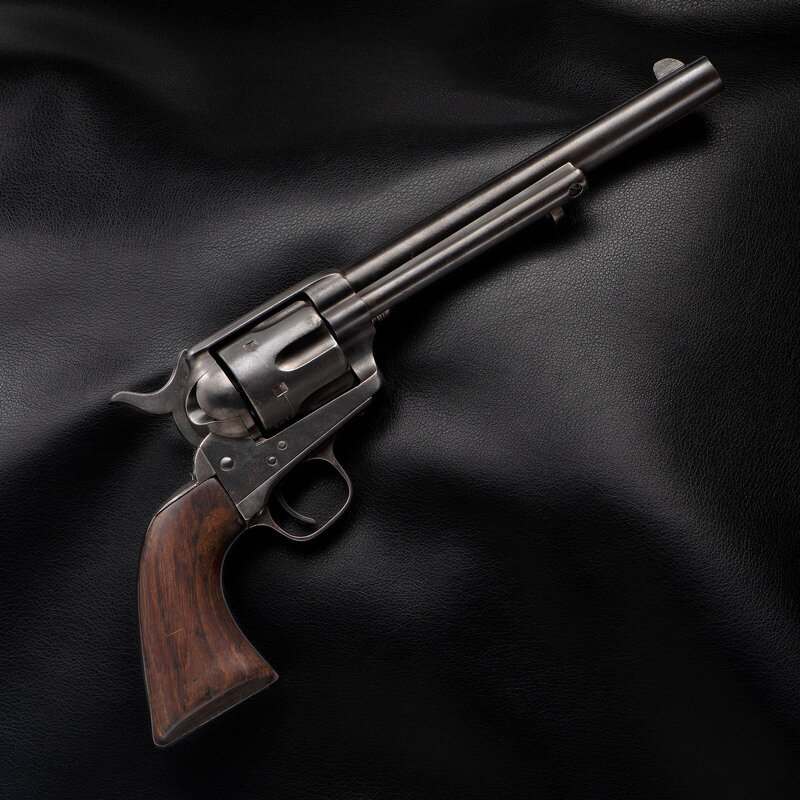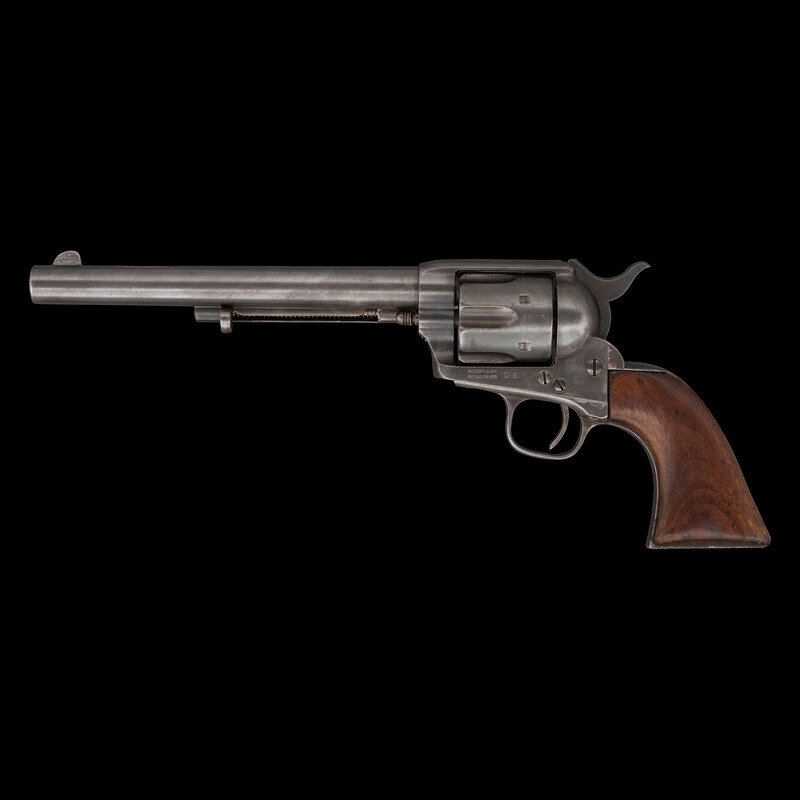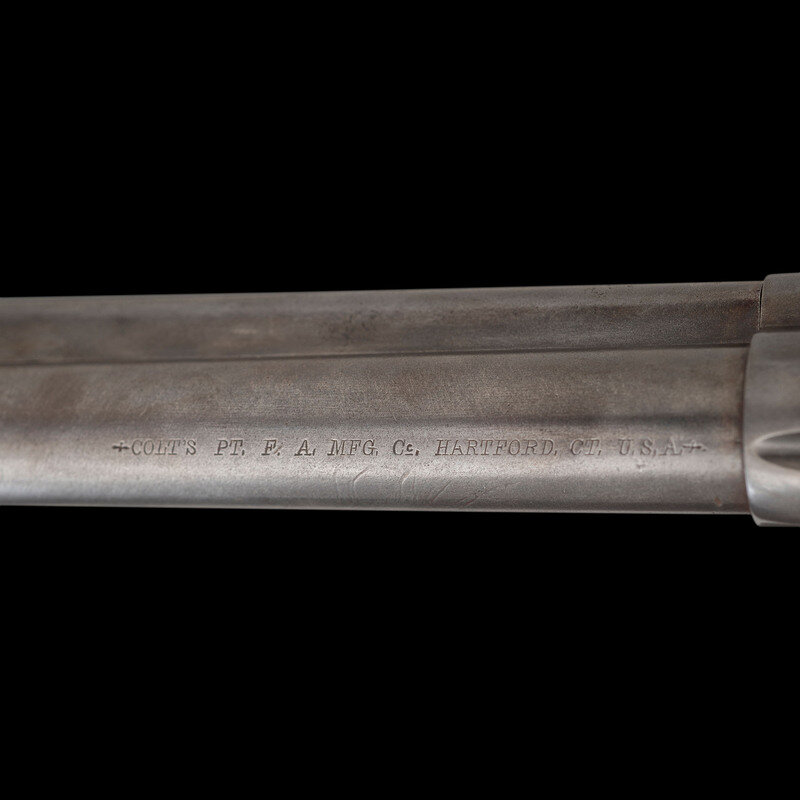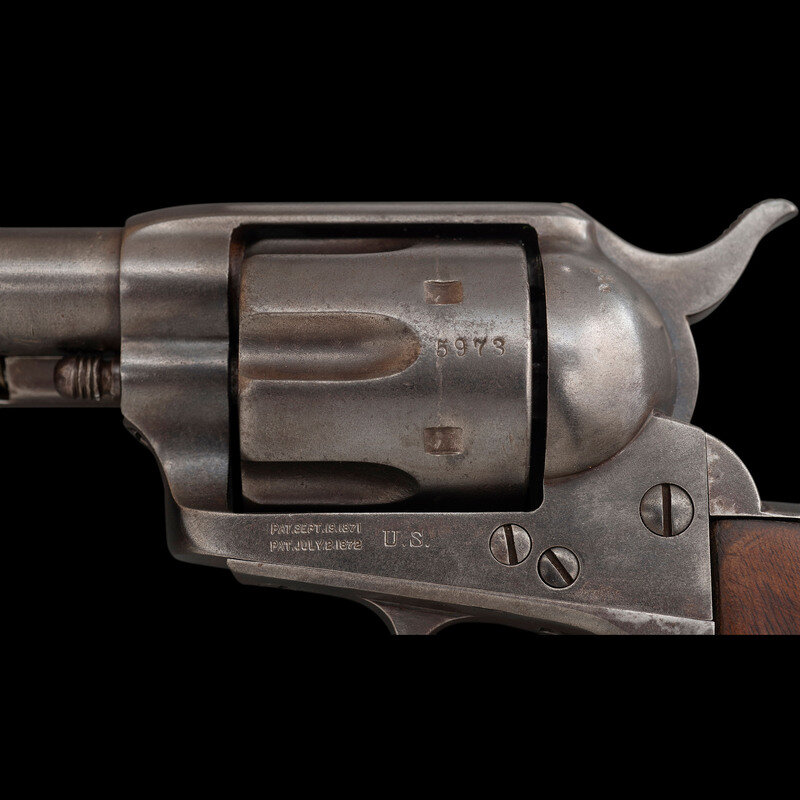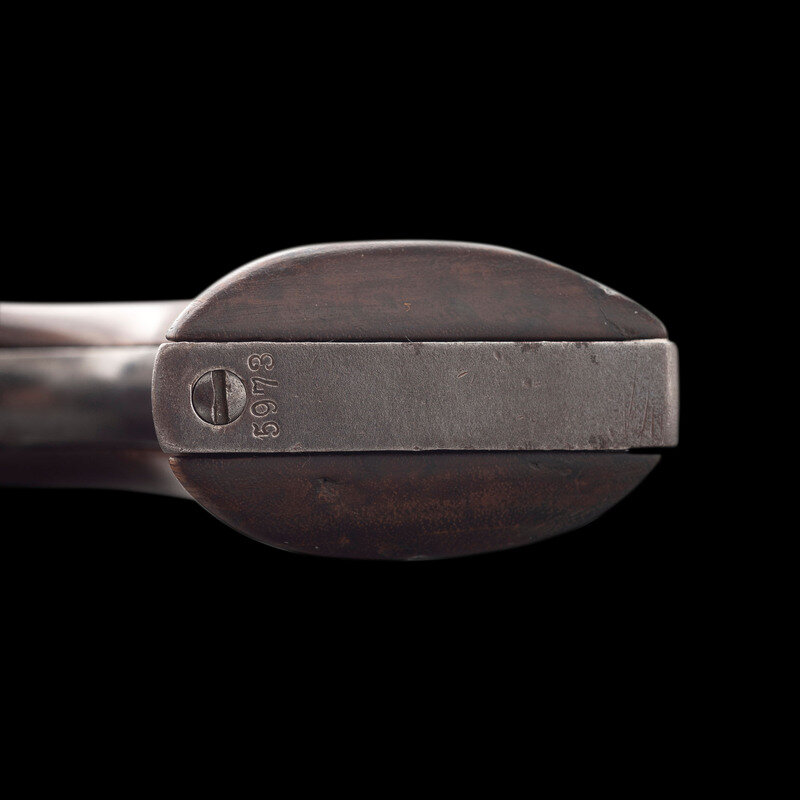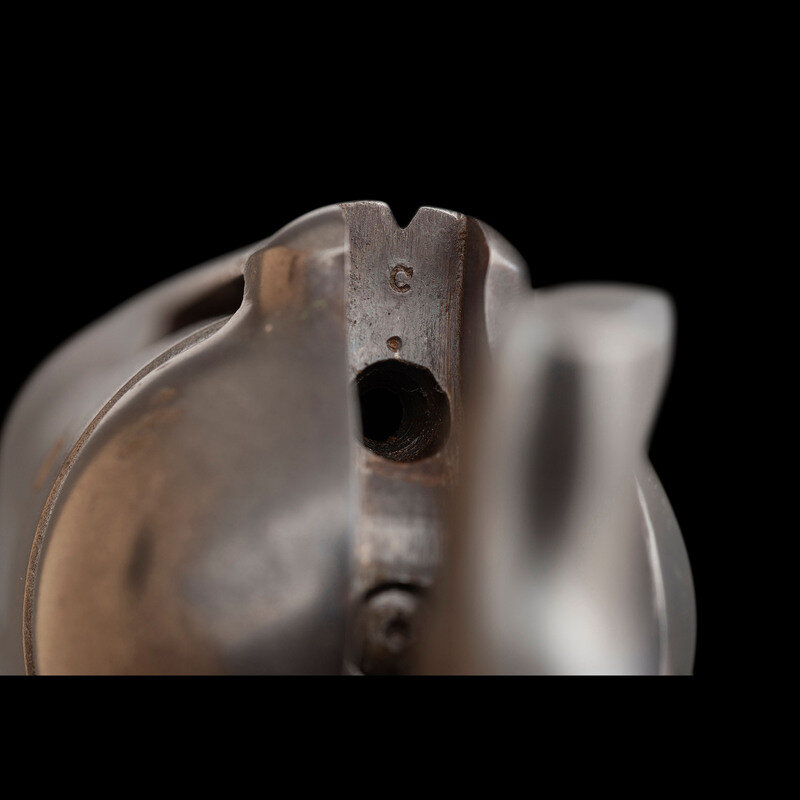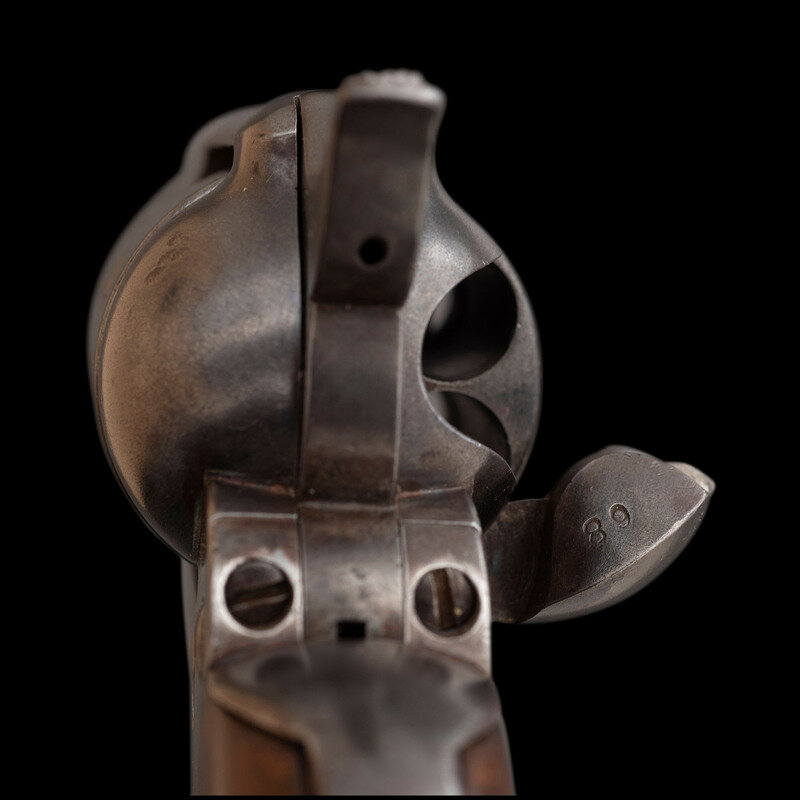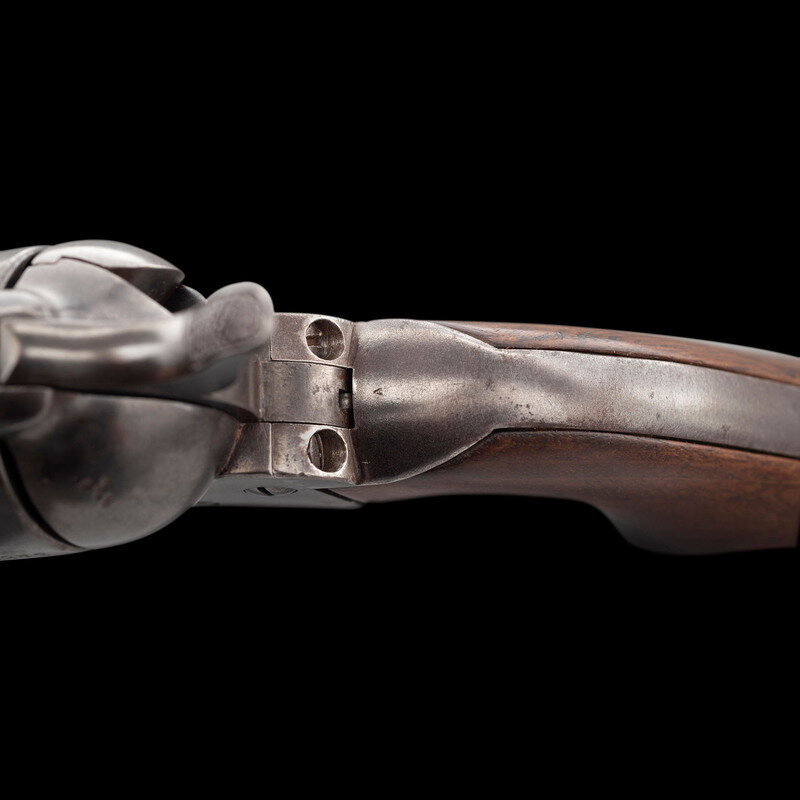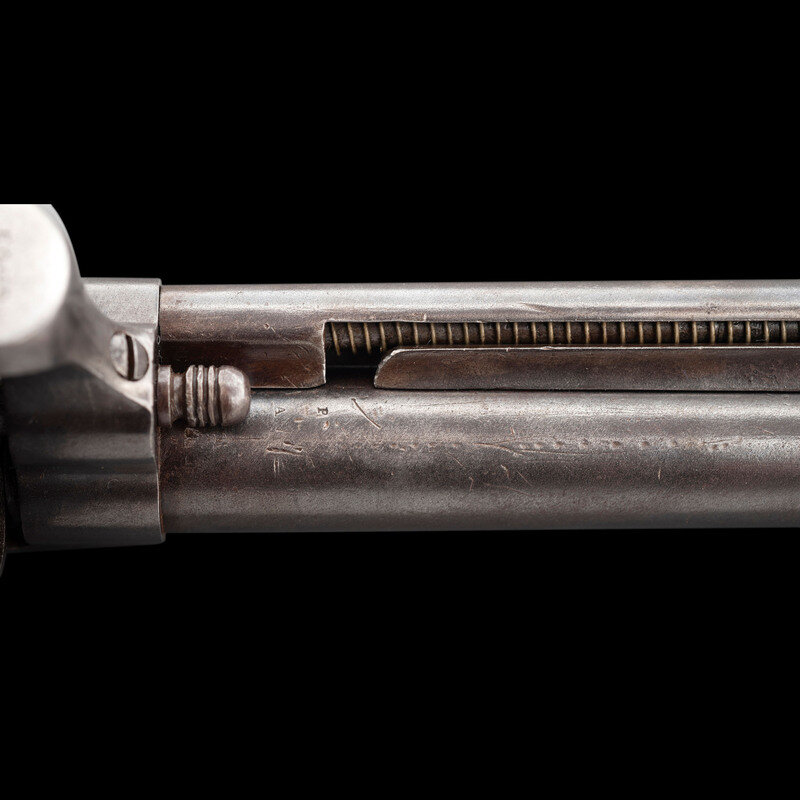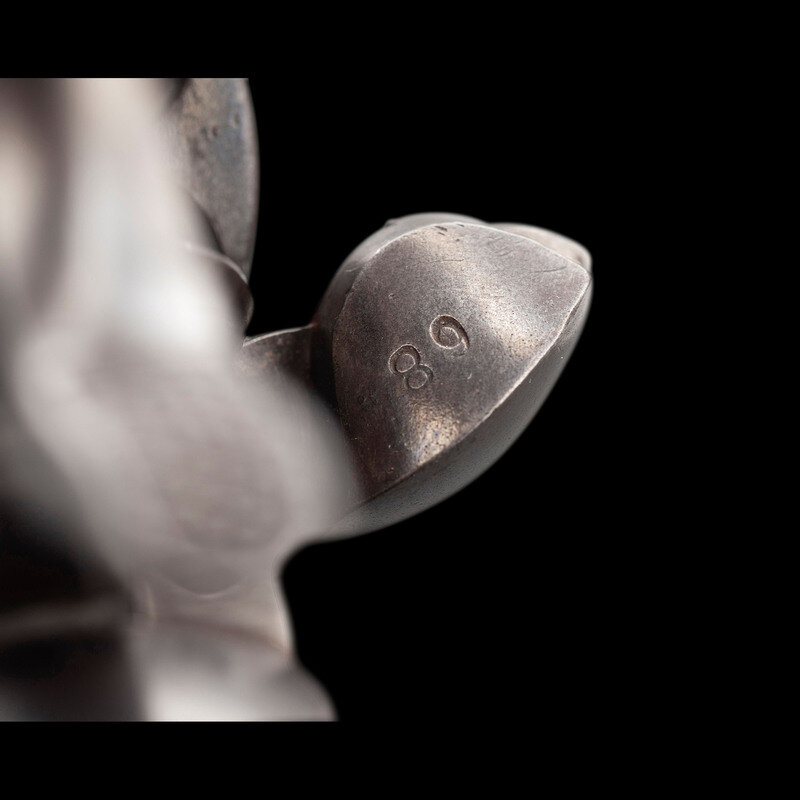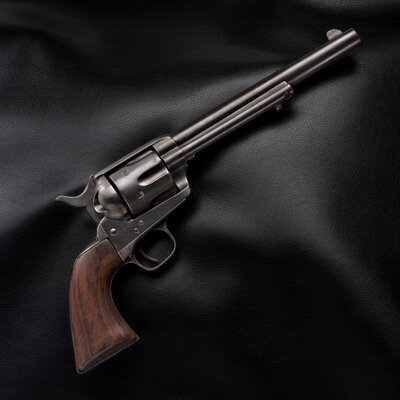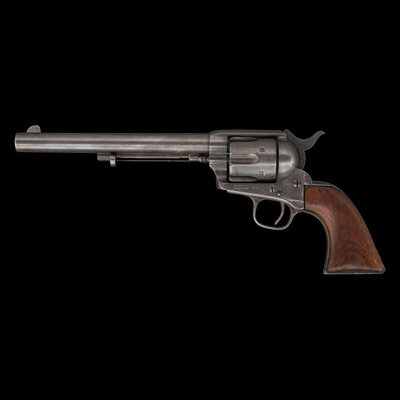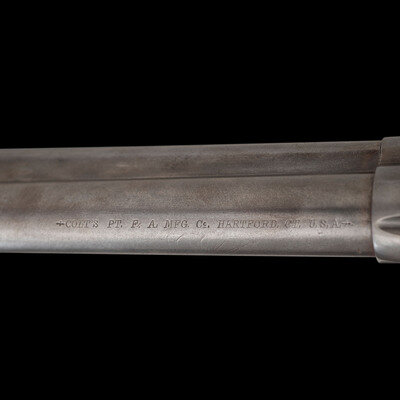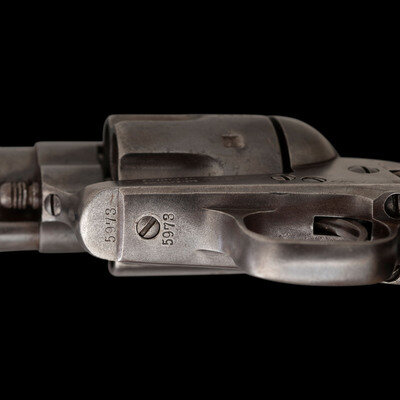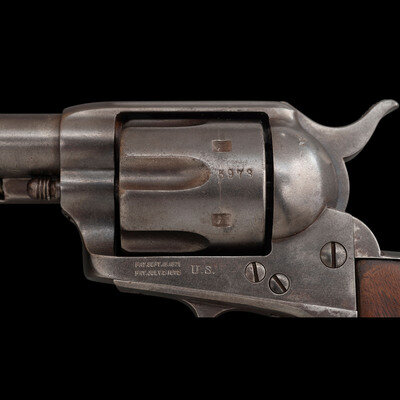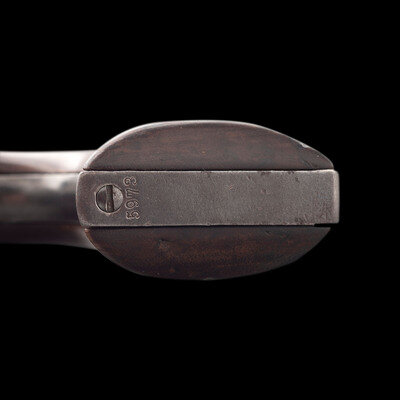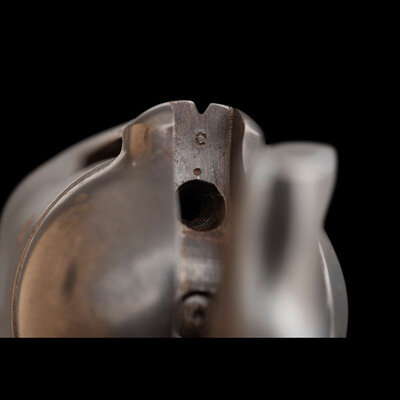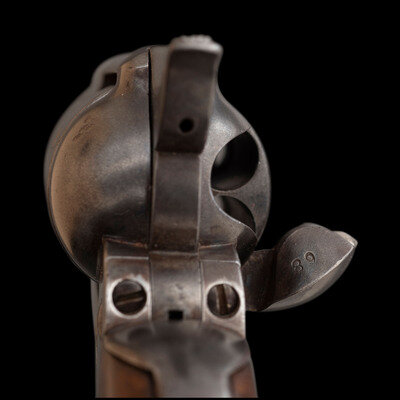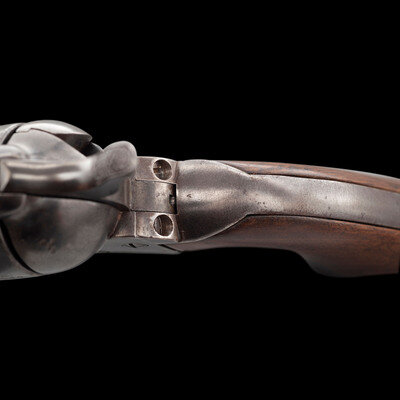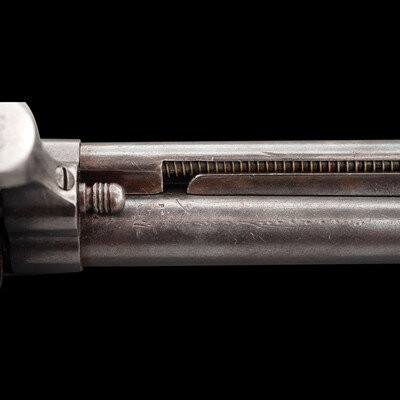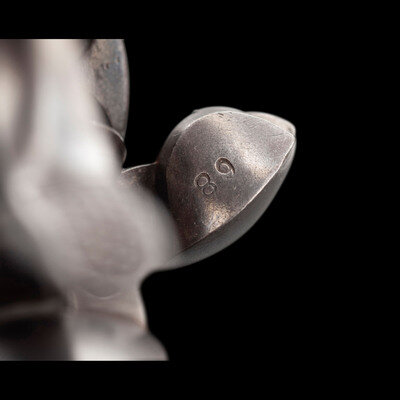Condition Report
Contact Information
Auction Specialists
Lot 79
Custer Range Colt Single Action Army Cavalry Revolver #5973 - A Lot 6 Delivery - Likely Picked Up at The Little Bighorn
Sale 1353 - Arms, Armor and Militaria
May 1, 2024
10:00AM ET
Live / Cincinnati
Own a similar item?
Estimate
$20,000 -
40,000
Price Realized
$45,000
Sold prices are inclusive of Buyer’s Premium
Lot Description
Custer Range Colt Single Action Army Cavalry Revolver #5973 - A Lot 6 Delivery - Likely Picked Up at The Little Bighorn
Indian Wars
.45 Colt. 7.5" Barrel. SN: 5973. Blued and color casehardened finish, smooth walnut one-piece grip. Single action black powder frame revolver with loading gate and a six-chambered fluted cylinder. The barrel of the revolver is roll marked with the one-line "script" address as John Kopec refers to it, italicized letters that reads: + COLT'S PT. F. A. Co. HARTFORD. CT. U.S.A. +. The address shows the expected small break in the "o" in "Co" on the upper right side, as well as the break in the upper right leg of the "A" in Hartford. Both the result of damage to the roll die and absolutely correct for this period of production. The lower front of the left side of the fame is marked with the "two-date in two-line" marking which reads: PAT. SEPT. 19, 1871/PAT. JULY 2, 1872. followed by a correctly stamped U.S. The matching complete serial number 5973 is stamped on the bottom of the frame, triggerguard and butt, as well as on the cylinder. It is also present on the barrel, under the ejector housing. The loading gate bears the assembly number 68 to match it to the frame. A correct tiny P proof is present under the barrel and on the cylinder and the correct Ainsworth sub-inspection A marks are present on the bottom of the frame, triggerguard and barrel, as well as on the backstrap and cylinder. The correct early production ejector rod housing with recess for the barrel locating stud is in place with the correct "bullseye" rod tip. The military checkered hammer is in place, with the usual frame notch rear sight and blade front sight. The barrel retains the correct pattern black powder rifling. The grip is an old replacement and is not numbered to the gun.
A letter of authenticity accompanies the revolver from John A. Kopec dated November 15, 2002 noting that at the time the revolver was a new gun in his on going survey of Single Action Army Revolvers and that the gun was entirely original with the exceptions that the grip was replaced, the front sight blade was increased in height at some point in time by welding, that the ejector tube mounting screw was a replacement and that the gun had been "artificially browned". More likely the gun was simply "toned" at some point in time, although the metal could simply retain the traces of an old, unprofessional refinish that did not involve any buffing of the metal.
The revolver is one of the coveted Lot 6 delivery guns, which fall in the serial number range of 5,505 to 6,516 which were inspected and delivered in February of 1874. The Lot 6 guns were shipped from Springfield Arsenal in April of 1874 for issue to three regiments of cavalry, including Custer's 7th Cavalry, as well as the 1st and 2nd US Cavalry Regiments. The second major issue of 7th Cavalry Single Action Revolvers was made from Lot 6, with their initial primary issue coming from the guns in Lot 5 (#4500-#5504). At least 166 Single Action Army revolvers were delivered to the 7th Cavalry from the Lot 6 deliveries, with the potential that as many as 300 or so were delivered to the 7th. The dearth of extant example revolvers in the 59XX serial number range certainly lends credence to the theory that most of those guns were captured at the Battle of the Little Bighorn. Due to the way in which the guns were issued and when the various companies of the 7th Cavalry initially received their revolvers, we know that Companies D (Weir) and I (Keogh) received their guns from Lot 6. It is not clear from which lot Company L received their revolvers, so another 73 Lot 6 guns may have been delivered to them.
On the day of the battle most of Companies I and L were under the direct command of Lt. Col. Custer and all 38 of the men in I company, along with the 46 in L company were killed that day, additionally 2 detached troopers from Company K died with Custer. All of their revolvers were lost in the field, where they were likely recovered by the Native American combatants. Company D was with Capt. Benteen's command and none of those men were killed that day with Custer, although 3 Company D troopers died in the fight on Reno Hill. Estimates place the number of revolvers lost by the 7th Cavalry during the battle at between 252 and 300. An additional letter from John Kopec, dated April 18, 2022 notes 18 known serial numbers in the 5,9XX range. Most of these do not have a specific historical association nor is is known to whom the guns were issued but several of these numbers are worth noting. #5988 was Reno's revolver. Interestingly #5989 was issued to the 2nd Cavalry, as were many of the Lot 6 guns. #5998 had the "US" markings obliterated, suggesting it was stolen or possibly acquired by the Native Americans. #5933 is a relic revolver recovered in Cypress Hill Alberta, Canada. Sitting Bull led his followers to Canada following the Battle of the Little Bighorn.
The primary evidence that links this revolver to the Battle of the Little Bighorn is it's chain of custody from the last quarter of the 19th century to today. Obviously when the revolver was manufactured it was initially delivered to the US Government in February of 1874 and was then shipped from Springfield Armory for field issue in April. At that time the gun was issued to either the 1st, 2nd or 7th Cavalry. The next documentable appearance of this revolver is in 1881 when it was traded by a Lakota Warrior to a Canadian merchant name Jean-Louis Legare in Wood Mountain, North-West Territories, Canada. The oral history related to this acquisition noted that the warrior received five packs of tobacco and a jug of whiskey in return for the gun. As Sitting Bull's followers were intending to return to the US during that year, it seems quite logical that the warrior chose to divest himself of the gun prior to presenting himself for surrender at a reservation. It was Legare, who led the band of Lakotas back to the United States. The revolver remained in that trader's family until 1948 when it was acquired from the family by Rex Burton Thrower who grew up near Cow Island, MT where Chief Joseph crossed the Missouri River during the Nez Perce War in their bid to take refuge in Canada in the fall of 1877. In 1998 Mr. Thrower sold the gun to an unrecalled gun collector who sold it to Keither Kristjanson of Grand Forks, ND at the Las Vegas Antique Arms Show in 2002. He sold it in 2017 to Mark Honeyman of Cascade, ID. In 2019 it was acquired by John R. Young of London, KY who sold it to Stephen R Dancey of Mendota, IL in 2021. In 2022 it was acquired by its current owner, David M. Dimmick of Murrayville, IL.
The excellent chain of custody makes it quite likely that the revolver was in fact recovered from the battlefield by a Native American warrior, that it traveled to Canada with Sitting Bull's band after the battle and that it is exactly what it appears to be, an authentic Cavalry Single Action that remains in nearly complete, original condition with fine provenance to support its authenticity. Two binders of research, provenance and information regarding the chain of custody are included with the gun, which also includes the aforementioned Kopec letters and correspondence.
A letter of authenticity accompanies the revolver from John A. Kopec dated November 15, 2002 noting that at the time the revolver was a new gun in his on going survey of Single Action Army Revolvers and that the gun was entirely original with the exceptions that the grip was replaced, the front sight blade was increased in height at some point in time by welding, that the ejector tube mounting screw was a replacement and that the gun had been "artificially browned". More likely the gun was simply "toned" at some point in time, although the metal could simply retain the traces of an old, unprofessional refinish that did not involve any buffing of the metal.
The revolver is one of the coveted Lot 6 delivery guns, which fall in the serial number range of 5,505 to 6,516 which were inspected and delivered in February of 1874. The Lot 6 guns were shipped from Springfield Arsenal in April of 1874 for issue to three regiments of cavalry, including Custer's 7th Cavalry, as well as the 1st and 2nd US Cavalry Regiments. The second major issue of 7th Cavalry Single Action Revolvers was made from Lot 6, with their initial primary issue coming from the guns in Lot 5 (#4500-#5504). At least 166 Single Action Army revolvers were delivered to the 7th Cavalry from the Lot 6 deliveries, with the potential that as many as 300 or so were delivered to the 7th. The dearth of extant example revolvers in the 59XX serial number range certainly lends credence to the theory that most of those guns were captured at the Battle of the Little Bighorn. Due to the way in which the guns were issued and when the various companies of the 7th Cavalry initially received their revolvers, we know that Companies D (Weir) and I (Keogh) received their guns from Lot 6. It is not clear from which lot Company L received their revolvers, so another 73 Lot 6 guns may have been delivered to them.
On the day of the battle most of Companies I and L were under the direct command of Lt. Col. Custer and all 38 of the men in I company, along with the 46 in L company were killed that day, additionally 2 detached troopers from Company K died with Custer. All of their revolvers were lost in the field, where they were likely recovered by the Native American combatants. Company D was with Capt. Benteen's command and none of those men were killed that day with Custer, although 3 Company D troopers died in the fight on Reno Hill. Estimates place the number of revolvers lost by the 7th Cavalry during the battle at between 252 and 300. An additional letter from John Kopec, dated April 18, 2022 notes 18 known serial numbers in the 5,9XX range. Most of these do not have a specific historical association nor is is known to whom the guns were issued but several of these numbers are worth noting. #5988 was Reno's revolver. Interestingly #5989 was issued to the 2nd Cavalry, as were many of the Lot 6 guns. #5998 had the "US" markings obliterated, suggesting it was stolen or possibly acquired by the Native Americans. #5933 is a relic revolver recovered in Cypress Hill Alberta, Canada. Sitting Bull led his followers to Canada following the Battle of the Little Bighorn.
The primary evidence that links this revolver to the Battle of the Little Bighorn is it's chain of custody from the last quarter of the 19th century to today. Obviously when the revolver was manufactured it was initially delivered to the US Government in February of 1874 and was then shipped from Springfield Armory for field issue in April. At that time the gun was issued to either the 1st, 2nd or 7th Cavalry. The next documentable appearance of this revolver is in 1881 when it was traded by a Lakota Warrior to a Canadian merchant name Jean-Louis Legare in Wood Mountain, North-West Territories, Canada. The oral history related to this acquisition noted that the warrior received five packs of tobacco and a jug of whiskey in return for the gun. As Sitting Bull's followers were intending to return to the US during that year, it seems quite logical that the warrior chose to divest himself of the gun prior to presenting himself for surrender at a reservation. It was Legare, who led the band of Lakotas back to the United States. The revolver remained in that trader's family until 1948 when it was acquired from the family by Rex Burton Thrower who grew up near Cow Island, MT where Chief Joseph crossed the Missouri River during the Nez Perce War in their bid to take refuge in Canada in the fall of 1877. In 1998 Mr. Thrower sold the gun to an unrecalled gun collector who sold it to Keither Kristjanson of Grand Forks, ND at the Las Vegas Antique Arms Show in 2002. He sold it in 2017 to Mark Honeyman of Cascade, ID. In 2019 it was acquired by John R. Young of London, KY who sold it to Stephen R Dancey of Mendota, IL in 2021. In 2022 it was acquired by its current owner, David M. Dimmick of Murrayville, IL.
The excellent chain of custody makes it quite likely that the revolver was in fact recovered from the battlefield by a Native American warrior, that it traveled to Canada with Sitting Bull's band after the battle and that it is exactly what it appears to be, an authentic Cavalry Single Action that remains in nearly complete, original condition with fine provenance to support its authenticity. Two binders of research, provenance and information regarding the chain of custody are included with the gun, which also includes the aforementioned Kopec letters and correspondence.
This lot is located in Cincinnati.
From the Collection of Dave Dimmick
Condition Report
Contact Information
Auction Specialists
